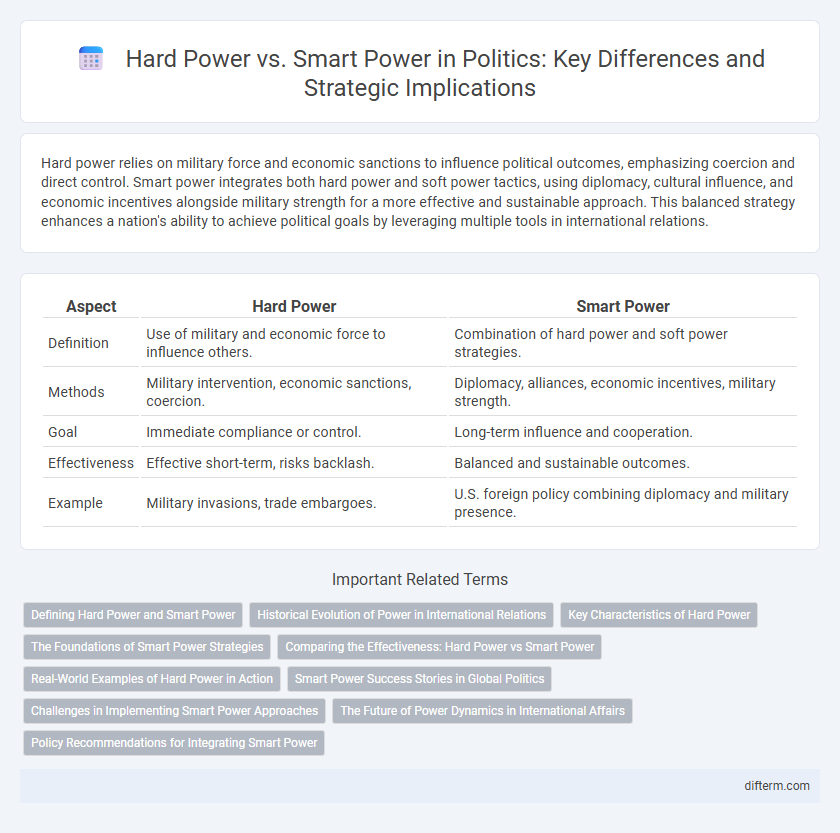Hard power relies on military force and economic sanctions to influence political outcomes, emphasizing coercion and direct control. Smart power integrates both hard power and soft power tactics, using diplomacy, cultural influence, and economic incentives alongside military strength for a more effective and sustainable approach. This balanced strategy enhances a nation's ability to achieve political goals by leveraging multiple tools in international relations.
Table of Comparison
| Aspect | Hard Power | Smart Power |
|---|---|---|
| Definition | Use of military and economic force to influence others. | Combination of hard power and soft power strategies. |
| Methods | Military intervention, economic sanctions, coercion. | Diplomacy, alliances, economic incentives, military strength. |
| Goal | Immediate compliance or control. | Long-term influence and cooperation. |
| Effectiveness | Effective short-term, risks backlash. | Balanced and sustainable outcomes. |
| Example | Military invasions, trade embargoes. | U.S. foreign policy combining diplomacy and military presence. |
Defining Hard Power and Smart Power
Hard power involves the use of military force, economic sanctions, or coercion to influence the behavior of other states, relying on tangible assets like armed forces and financial leverage. Smart power integrates these traditional hard power tools with diplomatic strategies, cultural influence, and economic partnerships to achieve foreign policy objectives more effectively. This approach emphasizes a balanced combination of coercion and attraction to expand a country's global influence and maintain security.
Historical Evolution of Power in International Relations
The historical evolution of power in international relations reveals a shift from traditional hard power, characterized by military force and economic coercion, to a more nuanced smart power approach that combines both hard and soft power resources. During the Cold War, hard power dominated as nations prioritized military alliances and deterrence strategies, while recent decades have seen the rise of smart power tactics involving diplomacy, cultural influence, and economic partnerships. This transition reflects an understanding that sustainable global influence requires integrating force with persuasion and legitimacy.
Key Characteristics of Hard Power
Hard power relies on coercive tactics such as military force, economic sanctions, and political pressure to influence other nations. Its effectiveness is measured by a country's ability to intimidate or compel compliance through tangible resources like armed forces and financial leverage. This approach emphasizes direct control and immediate impact in geopolitical conflicts and negotiations.
The Foundations of Smart Power Strategies
Smart power strategies integrate hard power elements like military and economic strength with soft power tools such as diplomacy, cultural influence, and international cooperation to achieve sustainable political objectives. The foundations of smart power emphasize the strategic deployment of resources to shape preferences and build long-term relationships while maintaining credible deterrence. This balanced approach enhances global influence and mitigates the risks associated with relying solely on coercion or attraction.
Comparing the Effectiveness: Hard Power vs Smart Power
Hard power relies on military strength and economic sanctions to compel behavior, often achieving immediate but temporary compliance. Smart power combines hard power with diplomatic engagement, cultural influence, and economic incentives to create sustainable and multifaceted solutions. Empirical studies show that smart power strategies yield longer-lasting outcomes by addressing underlying issues and building alliances, whereas hard power can provoke resistance and destabilization.
Real-World Examples of Hard Power in Action
The United States' military interventions in Iraq and Afghanistan exemplify hard power through direct use of force to achieve geopolitical objectives. China's assertive expansion in the South China Sea showcases hard power by deploying naval assets and constructing military installations to assert territorial claims. Russia's annexation of Crimea in 2014 demonstrates hard power through military occupation and coercion to alter international borders.
Smart Power Success Stories in Global Politics
Smart power strategies have driven notable successes in global politics by blending diplomatic engagement, economic incentives, and cultural influence to resolve conflicts, notably in the Iran Nuclear Deal and the Paris Climate Agreement. The United States and the European Union have effectively leveraged smart power to strengthen alliances, promote democratic values, and address challenges such as nuclear non-proliferation and climate change. These examples highlight how combining soft power with limited hard power capabilities creates sustainable solutions in complex international relations.
Challenges in Implementing Smart Power Approaches
Implementing smart power approaches faces challenges such as balancing military strength with diplomatic efforts while ensuring credible soft power. Limited resources and institutional resistance often hinder the integration of diverse strategies across agencies. Moreover, measuring the efficacy of smart power remains complex due to its multifaceted and long-term nature in political environments.
The Future of Power Dynamics in International Affairs
Hard power remains crucial in securing immediate strategic interests through military strength and economic sanctions, but smart power increasingly shapes international affairs by blending coercion with diplomacy, cultural influence, and technological innovation. Future power dynamics will rely on the ability of states to integrate cyber capabilities, soft power resources, and multilateral cooperation to address global challenges like climate change and security threats. This nuanced approach redefines dominance, emphasizing adaptability and the strategic use of diverse tools in fostering sustainable international relations.
Policy Recommendations for Integrating Smart Power
Policy recommendations for integrating smart power emphasize combining military strength with diplomatic, economic, and cultural tools to enhance international influence. Governments should invest in diplomatic initiatives, international aid, and public diplomacy to complement traditional hard power tactics, fostering cooperation and sustainable security. Effective integration requires adaptive strategies that balance force projection with soft power elements to address complex global challenges.
hard power vs smart power Infographic

 difterm.com
difterm.com